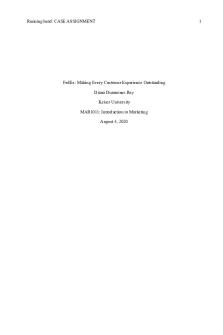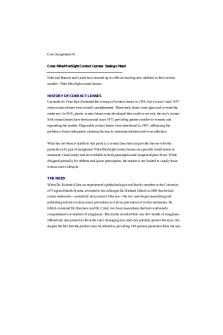Assignment Case 1 PDF

| Title | Assignment Case 1 |
|---|---|
| Author | jimmy pegerino |
| Course | Marketing II |
| Institution | University of Ontario Institute of Technology |
| Pages | 4 |
| File Size | 107.5 KB |
| File Type | |
| Total Downloads | 49 |
| Total Views | 149 |
Summary
First case assignment worth 5%...
Description
Case Assignment #1 Case: NikeMaxSight Contact Lenses: Seeinga Need
Nike and Bausch and Lomb have teamed up to offer an exciting new addition to the eyewear market—Nike MaxSight contact lenses.
HISTORY OF CONTACT LENSES Leonardo da Vinci first illustrated the concept of contact lenses in 1508, but it wasn’t until 1887 when contact lenses were actually manufactured. These early lenses were glass and covered the entire eye. In 1948, plastic contact lenses were developed that could cover only the eye’s cornea. Soft contact lenses have been around since 1971 providing greater comfort to wearers and expanding the market. Disposable contact lenses were introduced in 1987, addressing the problem of users adequately cleaning the lens to minimize irritation and even infection.
What has not been available to this point is a contact lens that can provide the eye with the protection of a pair of sunglasses! Nike MaxSight contact lenses are specially tinted lenses to maximize visual acuity and are available in both prescription and nonprescription form. While designed primarily for athletes and sports participants, the market is not limited to simply those with an active lifestyle. THE NEED When Dr. Richard Allen, an experienced ophthalmologist and faculty member at the University of Virginia Health System, revealed to his colleague Dr. Richard Edlich in 2000 that he had ocular melanoma—essentially skin cancer of the eye—the two men began researching and publishing articles on skin cancer prevention as well as prevention of ocular melanoma. Dr. Edlich contacted Dr. Reichow and Dr. Citek, two basic researchers that had conducted a comprehensive evaluation of sunglasses. The results revealed that very few brands of sunglasses offered any real protection from the sun’s damaging rays and only partially protect the eyes; this despite the fact that the product may be labeled as providing 100 percent protection from the sun.
There are a number of reasons that sunglasses don’t do the job. First, they have to be worn to do any good. Many sunglasses have poor quality lens material that does not adequately shield the eyes from the damaging UVA and UVB rays that also cause skin cancer. Design and fit can also minimize the effectiveness of sunglasses. Uncomfortable, unable to adequately cover the eye, and unlikely to stay in place during activity, sunglasses were not the answer.
THE SOLUTION Doctors Reichow and Citek played a leadership role in coordinating the development of the Nike MaxSight fully tinted soft contact lens. Nike MaxSight contact lenses for athletes come in two tints: gray-green contacts for athletes who play in bright sunlight and want to be comfortable visually (golf, rugby, runners) and amber-tinted contacts for athletes in sports that require tracking of fast-moving objects (baseball, soccer, tennis, softball). The lenses come in both prescription and nonprescription form and as with most daily wear soft contacts, they must be changed monthly.
Benefits of Nike MaxSight lenses are substantial. Not only do wearers have a better field of view with no obstructions from nosepieces or frames, but there’s also no fogging. You’ll still sweat while exercising but that sweat isn’t causing glasses to slip and slide. This lens provides distortion-free optics, whether or not you wear prescription contacts. The lenses filter out more than 90 percent of harmful blue light as well as 95 percent of UVA and UVB rays. Nike still recommends wearing sunglasses whenever possible over MaxSight lenses to protect the rest of the eye. P PENDIX D ALTERNATE CASES A box of Nike MaxSight lenses costs about $60 for a two-month supply. Conventional prescription contact lenses sell for around $25 to $70 depending on prescription.
Nike MaxSight lenses are available from selected eye care professionals. The Nike Web site (www.nikevision.com) provides information on these outlets. Consumers are unable to purchase the product unless they have an eye examination and fitting.
One primary tactic for providing information on the product for both consumers and eye care providers is the Nike Web site. A downloadable coupon is available for a free trial pair of lenses. In-store product information and displays are provided to eye care professionals to reach potential consumers. Nike also has traditional advertising on the product in selected sports magazines. Questions
1. How has Nike used an analysis of consumer needs to identify different markets and products for MaxSight? What are these different market–product combinations? 2. Which market segments are likely to be the largest? Explain why. The most likely to adopt the product? Explain why. 3. Identify the elements of the marketing mix for Nike MaxSight currently. What marketing mix recommendations do you suggest beyond those Nike has already undertaken?
4. This product is positioned toward athletes who want to improve their performance and visual acuity. However, it may be difficult for anyone who does not already wear contact lenses to be motivated to adopt this product. (a) How likely is it that Nike will be able to capture noncontact lens-wearing athletes? (b) What can Nike do to encourage the noncontact lens-wearing athlete to adopt the product?
1) Nike analyzed consumer needs by using basic and similar products already on the market. They found that there were some similar products which were unsuccessful and took advantage of that to complete the product to the company’s specific liking and wants. These different market-product combinations are athletes who play sports where sunglasses are needed to be able to play a sport properly and for those who wear prescribed glasses and would like to take advantage of wearing contacts that help block the sun out too. 2) The sporting market seems to be the largest because these will be useful for athletes. Their career is playing sports and the contacts will drastically benefit athletes to perform better when the sun is hitting outdoors, compared to having sunglasses which may be a distraction when participating in events. Athletes and those who wear glasses are most likely to adopt to the lens as athletes can perform better as mentioned before. Those who wear glasses don’t need to have the hassle of buying expensive glasses which have lens that could adapt to the light, or carry 2 pairs around. Some people may not even enjoy wearing glasses, so this way they will be able to wear the lens and still block out the brightness. 3) The elements of the marketing mix are product, price, place and promotion. The product is straight forward and is a box of 2-month supply of the contacts. Price is set at $60 for the 2-month supply on the lens box. The product is set to be sold at selected eye care specialists whom will perform testing and see which set is suitable for the customer. Promotion wise is Nike offering a coupon which gives customers a free trial pair of lenses. This trial will allow those who are interested to see if the lenses will be beneficial to the customer with what they do on a daily basis, and if it suitable for them. 4) A) It is very likely that Nike is able to attract noncontact lens-wearing athletes as when athletes wear sunglasses it is a distraction, and in some sports such as soccer or football, it is not really recommended and comfortable to be playing with glasses. With the lenses, they will be able to play at their own comfort with no distractions or addons which will have to be adjusted every now and then while playing. B) To encourage noncontact lens-wearing athletes to adopt to the product Nike could promote some ads where there are sports which are out in the sun, and having a pair of sunglasses could be beneficial to the player, but the discomfort, and having to worry about something on your face may be a distraction so the lens is out of the way, and won’t even feel like anything is there to be a distraction in the way of the athletes performance....
Similar Free PDFs

Week 1 Case Assignment
- 4 Pages

Assignment 1 case study
- 10 Pages

Assignment 1 CASE Study
- 9 Pages

Assignment 1 Zipcar Case
- 2 Pages

Case Study Assignment 1
- 21 Pages

Assignment Case 1
- 4 Pages

Assignment Case Study-1
- 6 Pages

Case 1 - Airbnb and Assignment
- 4 Pages

Avion case study 1 - Assignment
- 4 Pages

CASE Study 1- Facebook - Assignment
- 19 Pages

Assignment 1 Case Study (Hausboom)
- 14 Pages

Legal Case Briefing Assignment 1
- 4 Pages

BUSI 472 Case Assignment 1
- 8 Pages

RSM251 Case 1 Assignment Report
- 14 Pages
Popular Institutions
- Tinajero National High School - Annex
- Politeknik Caltex Riau
- Yokohama City University
- SGT University
- University of Al-Qadisiyah
- Divine Word College of Vigan
- Techniek College Rotterdam
- Universidade de Santiago
- Universiti Teknologi MARA Cawangan Johor Kampus Pasir Gudang
- Poltekkes Kemenkes Yogyakarta
- Baguio City National High School
- Colegio san marcos
- preparatoria uno
- Centro de Bachillerato Tecnológico Industrial y de Servicios No. 107
- Dalian Maritime University
- Quang Trung Secondary School
- Colegio Tecnológico en Informática
- Corporación Regional de Educación Superior
- Grupo CEDVA
- Dar Al Uloom University
- Centro de Estudios Preuniversitarios de la Universidad Nacional de Ingeniería
- 上智大学
- Aakash International School, Nuna Majara
- San Felipe Neri Catholic School
- Kang Chiao International School - New Taipei City
- Misamis Occidental National High School
- Institución Educativa Escuela Normal Juan Ladrilleros
- Kolehiyo ng Pantukan
- Batanes State College
- Instituto Continental
- Sekolah Menengah Kejuruan Kesehatan Kaltara (Tarakan)
- Colegio de La Inmaculada Concepcion - Cebu

